CPT International 4/2019
Create successful ePaper yourself
Turn your PDF publications into a flip-book with our unique Google optimized e-Paper software.
PRESSURE DIE CASTING<br />
High usage<br />
Medium usage<br />
Low usage<br />
> 6 large components<br />
• S sport coupés<br />
• F luxury cars<br />
4-6 large components<br />
• E executive cars<br />
• J sport utility cars<br />
1-3 large components<br />
• D large cars<br />
• E executive cars<br />
Exemplary<br />
components<br />
<br />
<br />
<br />
<br />
<br />
Front shock towers<br />
Rear shock towers<br />
Longitudinal beams<br />
Firewall<br />
Other<br />
Exemplary<br />
components<br />
<br />
<br />
<br />
Front shock towers<br />
Rear shock towers<br />
Longitudinal beams<br />
Firewall<br />
Other<br />
Exemplary<br />
components<br />
<br />
<br />
Front shock towers<br />
Rear shock towers<br />
Longitudinal beams<br />
Firewall<br />
Other<br />
Source: Roland Berger<br />
Graphics: Roland Berger<br />
Figure 1: Current usage for structural components in the automotive market.<br />
advanced thermal management, the<br />
use of new alloys and careful product<br />
design could drive down production<br />
costs even further. Hereby die-cast structural<br />
components get more cost-effective<br />
for the mass car market. With new<br />
car production predicted to hit the 110<br />
million vehicle mark in 20231, and with<br />
between two and six structural components<br />
per car, these technological<br />
advances could potentially transform<br />
the opportunity for die casters around<br />
the world. If the manufacturing chain<br />
– from die-casting machine manufacturers,<br />
to foundries and OEMs – work<br />
together, it will be possible.<br />
3.3<br />
0.6<br />
0.5<br />
2.2<br />
5.9<br />
0.7<br />
2.2<br />
3.1<br />
+3 m units<br />
8.2<br />
0.8<br />
3.3<br />
4.0<br />
8.9<br />
0.8<br />
3.8<br />
4.4<br />
High user<br />
(>6 parts)<br />
Medium user<br />
(4-6 parts)<br />
Low user<br />
(1-3 parts)<br />
Why are die-cast structural components<br />
so attractive to the automotive<br />
industry?<br />
Die-casting foundries around the world<br />
are seeing fundamental changes in the<br />
automotive industry that are profoundly<br />
affecting the industry. Consumer<br />
demand and environmental regulation<br />
is driving significant changes in the<br />
kind of cars people want to drive and<br />
how they want to use them. Electric<br />
mobility is developing at a fast pace,<br />
with global sales more than doubling,<br />
from around 2 million in 2017 to 5.1<br />
million in 2018 [2].<br />
Every car manufacturer is focused on<br />
producing more sustainable vehicles –<br />
preferably at a lower cost. And a key<br />
element in reducing fuel consumption,<br />
extending battery range or reducing<br />
emissions, is in making cars that weigh<br />
less. This is the motivation that is fueling<br />
the growing demand for structural<br />
components.<br />
2015<br />
2018<br />
vehicle architectures in million units<br />
The role of die-casting technology<br />
in vehicle weight reduction<br />
Die casting large structural components<br />
is a proven route to reduce weight in<br />
vehicles. Die casting in aluminum alloys<br />
delivers exceptional strength and good<br />
formability, but with less weight than<br />
traditional steel structures.<br />
This drive for lighter weight is independent<br />
of powertrain selection. As<br />
debates over the best sustainable motoring<br />
solutions rage, from ICE, PHEV,<br />
HEV, EV even hydrogen, and consumer<br />
attitudes and regional and local regulation<br />
skew demand across markets,<br />
investing in the production of structural<br />
components is a clear strategic solution<br />
for many die-casting foundries.<br />
2021<br />
2025<br />
Figure 2: Predicted growth in current structural components, 2015 to 2025.<br />
Pioneered in the German luxury car<br />
market, die-cast structural components<br />
are now being used in wider categories<br />
of vehicle, for a range of applications.<br />
(Figure 1).<br />
An important application<br />
for die casting<br />
S sport coupés and F segment luxury<br />
cars currently use the widest range of<br />
die-cast structural components, including<br />
front and rear shock towers and<br />
longitudinal beams designed for the<br />
dissipation of crash energy. The Jaguar<br />
I-PACE actually uses 15 structural components<br />
on each vehicle. E segment<br />
executive cars and J segment sports utilities<br />
use die-cast components in shock<br />
22

















